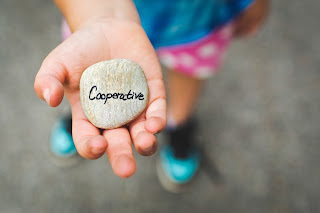This is the first in
a series of articles that I wrote, based on questions I receive.
Please send me more questions ( wishyouhealthyrelationship@gmail.com) and, if you find this article useful,
please like our page on Facebook ( https://www.facebook.com/communicationandmore
).
It is often said
that in order to have a happy intimate relationship, we need to
compromise. The other person gives up some, I give up some and that
way we reach a point where you have two people who are giving up. With this article
I’ll show you that there is a much better way.
 Meet Janet and Mark
(I changed the names to guarantee privacy). I work with Janet, as she
is the one to realize that their relationship is fast steering
towards the rocks. Janet and Mark have a business together.
Meet Janet and Mark
(I changed the names to guarantee privacy). I work with Janet, as she
is the one to realize that their relationship is fast steering
towards the rocks. Janet and Mark have a business together.
Janet finds some of
the things that Mark does, in his everyday dealings, very difficult to
accept, and she is building up more and more resentment towards him
as he seems, in her words: “not to care”.
Janet and I decide
to work on one specific thing that Mark does and that she finds
really, really hard to deal with.
According to Janet,
Mark leaves his tools, such as screwdrivers, hammer, wrenches,
etc...right in front of the entrance of their business, causing
visual clutter and, sometimes, as screwdrivers have a tendency to
roll, they create a situation where guests need to jump over them.
Janet tells me she
has addressed this issue with Mark several times, with no change.
Over the weeks that
we work together, we are able to clarify a few things:
First, that when
Janet sees the tools by the entrance to the business, she gets
disturbed because some of her basic human needs are not met,
specifically:
beauty (she
perceives them as ugly at the entrance)
harmony (similar to
the above)
cooperation (Mark
leaving tools there even after she addressed it with him)
consideration (this
and all following needs, similar to the above)
inclusion
mutuality
to be heard
safety (clients
could trip over them)
Secondly, that
because of lots of similar events in their relationship, in which
messages seem to get lost in the ether, her level of resentment has
reached historical levels and that, if we want to put it on a
time-scale, she is at 1 minute to twelve, in terms of quitting the
relationship. On the other hand, she deeply cares about him and the
relationship and is really, really desperate to find a way to
communicate with him, as she realizes that she is not managing.
Thirdly, related
closely to point number two, we are able to identify that her way of
communicating is mostly based on threats. Even when she doesn’t use
the actual words, she is still falling into the retaliatory formula:
“if you don’t do this, I will do that”. Clearly, when we
address anyone in this way, we get a protective reaction from them as they feel threatened,
and their fight-flight-freeze mechanisms kick in.
With these three
points, we were able to get quite some work done over a period of
four weeks. We started by addressing point three: use of
communication.
Janet was able to
see that if she wanted to make headway, she needed to approach Mark
with different communication skills. In particular, she needed to be
able to develop different listening skills so that she would be able to
relate to his basic human needs. Why is this important? Because when
we meet at the level of basic human needs we are meeting on a level
playing field, where the potential for human connection is extremely
high. This level playing field is often referred to as empathy.
So, over the weeks
we spent together, Janet was able to approach Mark with “big ears”,
with the ability to actually, fully hear what he was saying about the
tools being where he left them.
She was able to
establish that this strategy that he chose was really used to fulfill
his basic human needs for:
ease (having them
close to him when he needs them)
self-expression
(this and the ones below, related to the basic human needs for
autonomy)
choice
freedom
independence
space
So can you notice
how a very interesting thing is happening here? We have an almost
mathematical equation being born here: we have narrowed things down
to a few common denominators, a few basic human needs; basic human
need that we all share and that we can relate to:
Janet has mostly
needs for beauty and inclusion as most prominent ones, while Mark has
needs for peace and autonomy as strong ones, in this moment of his
life.
When we finally came
to this point, it was easy to create some common working strategies
between Jane and Mark. During one of the Skype get-togethers that
Jane and I had, we started an exercise in creative thinking; in other
words, we started creating a list of practical ways (strategies) that
she could suggest to Mark, to fulfill the needs of both.
We started off the
list with about 10 strategies and narrowed it down to about 2 or 3.
Now we were facing
the moment of truth. Would Mark take to any of the strategies that
Jane was about to suggest?
I was really keeping
my fingers crossed and feeling intrepid, till our next meeting.
A week passed and we
got back on tele-conferencing. I was waiting with excitement for
news. Jane told me that, over the weeks that we had worked together,
she had started to act quite differently with Mark. In a way,she was
better able to see his “humanity” and to accept the points that
she, until recently, had chosen to see as “flaws”.
By the same token,
she was able to try and guess what his basic human needs were, after
we built up a bit of “needs fluency” for her. In so doing, she
was able to connect to him in a completely different way, coming from
a point of love and care most of the time, without labeling Mark as
“slob” or “lazy”. Furthermore, by doing this work, by
exercising her mind in this way, she was able to come up with a
strategy that worked for both:
 The tools would,
from now on, Mark agreed to this, be left at a certain distance from
the door, in such a way that they would not be too prominent yet, in
such a way that he could grab them without further ado.
The tools would,
from now on, Mark agreed to this, be left at a certain distance from
the door, in such a way that they would not be too prominent yet, in
such a way that he could grab them without further ado.
I hope that this
article has shown you how easy it is to connect, when there is will
by at least one person to create deep and meaningful engagement,
without the need to compromise by anyone.
If you would like to
receive, for free, on a weekly basis our communication tips that
could help you create crystal clear, misunderstanding free
connections in situations like the one you just read about, then
subscribe now ( https://people-and-communication.com/blog-archive/
). If you prefer one-on-one sessions, I (Jerry) have always two free sessions available for you, that you can sign up for by emailing me ( wishyouhealthyrelationship@gmail.com ). We all look forward to speaking with you! The team of Online Academy
for Communication.









